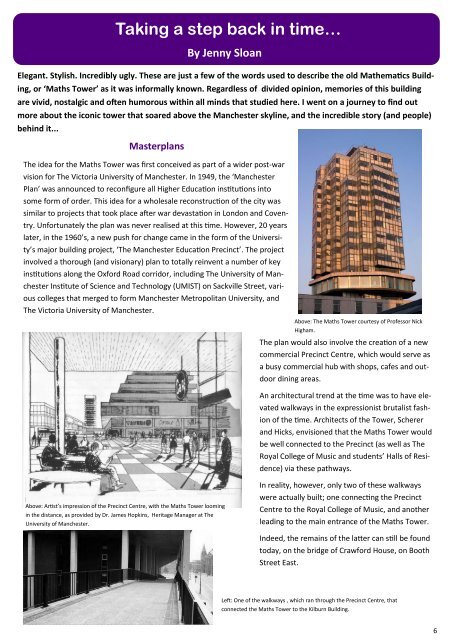Alumni Newsletter
June-2016-Alumni-Newsletter
June-2016-Alumni-Newsletter
You also want an ePaper? Increase the reach of your titles
YUMPU automatically turns print PDFs into web optimized ePapers that Google loves.
Taking a step back in time…<br />
Elegant. Stylish. Incredibly ugly. These are just a few of the words used to describe the old Mathematics Building,<br />
or ‘Maths Tower’ as it was informally known. Regardless of divided opinion, memories of this building<br />
are vivid, nostalgic and often humorous within all minds that studied here. I went on a journey to find out<br />
more about the iconic tower that soared above the Manchester skyline, and the incredible story (and people)<br />
behind it...<br />
Masterplans<br />
The idea for the Maths Tower was first conceived as part of a wider post-war<br />
vision for The Victoria University of Manchester. In 1949, the ‘Manchester<br />
Plan’ was announced to reconfigure all Higher Education institutions into<br />
some form of order. This idea for a wholesale reconstruction of the city was<br />
similar to projects that took place after war devastation in London and Coventry.<br />
Unfortunately the plan was never realised at this time. However, 20 years<br />
later, in the 1960’s, a new push for change came in the form of the University’s<br />
major building project, ‘The Manchester Education Precinct’. The project<br />
involved a thorough (and visionary) plan to totally reinvent a number of key<br />
institutions along the Oxford Road corridor, including The University of Manchester<br />
Institute of Science and Technology (UMIST) on Sackville Street, various<br />
colleges that merged to form Manchester Metropolitan University, and<br />
The Victoria University of Manchester.<br />
By Jenny Sloan<br />
Above: The Maths Tower courtesy of Professor Nick<br />
Higham.<br />
The plan would also involve the creation of a new<br />
commercial Precinct Centre, which would serve as<br />
a busy commercial hub with shops, cafes and outdoor<br />
dining areas.<br />
An architectural trend at the time was to have elevated<br />
walkways in the expressionist brutalist fashion<br />
of the time. Architects of the Tower, Scherer<br />
and Hicks, envisioned that the Maths Tower would<br />
be well connected to the Precinct (as well as The<br />
Royal College of Music and students’ Halls of Residence)<br />
via these pathways.<br />
Above: Artist’s impression of the Precinct Centre, with the Maths Tower looming<br />
in the distance, as provided by Dr. James Hopkins, Heritage Manager at The<br />
University of Manchester.<br />
In reality, however, only two of these walkways<br />
were actually built; one connecting the Precinct<br />
Centre to the Royal College of Music, and another<br />
leading to the main entrance of the Maths Tower.<br />
Indeed, the remains of the latter can still be found<br />
today, on the bridge of Crawford House, on Booth<br />
Street East.<br />
Left: One of the walkways , which ran through the Precinct Centre, that<br />
connected the Maths Tower to the Kilburn Building.<br />
6


